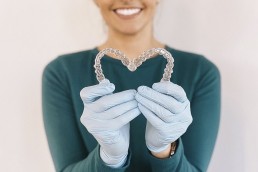To celebrate October — National Orthodontic Health Month — we want to take you on a journey back to the foundation of orthodontics. While orthodontics may seem like the most modern branch of dentistry, its origins date back to the Ancient Egyptians. The human species has long desired to achieve “the perfect smile” and attempted to do so through the use of varied devices and techniques.
Mummies With Braces
Poorly aligned teeth and jaws have affected humans’ ability to speak and chew for thousands of years. We know this because archaeologists have unearthed Egyptian mummies with metal bands attached to their teeth, similar to what we do in modern times with braces. Instead of wires, they appeared to use a thin, strong cord made from sheep or goat intestines called catgut, to close gaps in teeth.
Around 700 B.C., we have proof that the ancient civilization of the Etruscans placed gold bands in the mouths of the deceased to maintain spaces and prevent collapse of teeth. We also have record that around 500 B.C., the Greek physician Hippocrates, along with philosopher Aristotle, each considered methods for improving dental conditions and straightening teeth.
Not Sure What an Orthodontic Term Means?
The Invention of Braces
What we know today as “braces” dates back to the early 1700s. A French dentist by the name of Pierre Fauchard published a book in 1728 titled, The Surgeon Dentist, which contains a chapter about straightening teeth. Dr. Fauchard used pieces of thread to connect flat metal strips to patients’ teeth, and today we credit him for the invention of modern braces. He also used a device called the “bandeau” to widen the upper palate.
In 1819, dentists started using precious metals, steel, gum rubber, and vulcanite to create loops, hooks, spurs and ligatures to straighten teeth. Fast forward to the 19th century, and the turn “orthodontia” was first used by Joachim Lafoulon in 1841, meaning, “treatment for the correction of irregularly aligned teeth, usually involving braces and sometimes oral surgery.”
Present Day Orthodontics
Edward Angle, considered to be the Father of Modern Orthodontics, invented modern brackets in 1915. Dr. Angle first identified the true properties of malocclusion (misalignment of the teeth) and addressed them with a set of advanced orthodontic appliances. He founded the American Association of Orthodontics and started the first independent school of orthodontics. Dr. Angle’s brackets were fixed to small bands and worn around each individual tooth. In 1928, the invention improved by creating a single bracket that could be attached directly to the tooth — what we continue to use today with metal braces.
The field of orthodontics continues to improve, with health and comfort being the two main priorities. Advances in technology over the past few decades — such as digital x-rays and imaging that provide a more detailed look inside a patient’s mouth — allow us to create a customized treatment plan. The variety of braces available today has also evolved, with two main types of braces to choose from:
- Metal Braces: Adhered to the teeth with metal brackets, elastics and wires, braces use constant, gentle pressure to move teeth into the proper position.
- Invisalign: Using a set of clear, removable and custom-made aligners, Invisalign shifts teeth in incremental steps to the desired final position.
If you’d like to see how far we’ve come today from the early days of orthodontics, don’t hesitate to reach out! And if you think you or your child are a good candidate for braces or Invisalign, schedule a complimentary consultation today and come talk to us about your curiosity. We look forward to meeting you!
Ready to schedule a free consultation?
April 7, 2020
A diastema, or gap between teeth, is usually a natural part of a child’s development. For many children, the gap between their two front teeth closes with the…
March 4, 2020
We all love a good transformation story, and there’s nothing better than celebrating our patients’ incredible orthodontic treatment journeys. In this post,…
January 15, 2020
The alignment of your teeth can drastically impact your health and overall comfort. If you or your child are consistently experiencing jaw pain, frequent…


